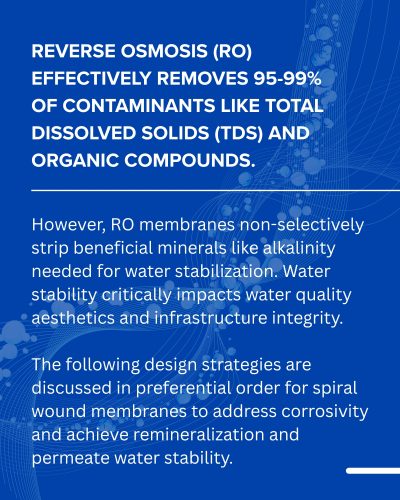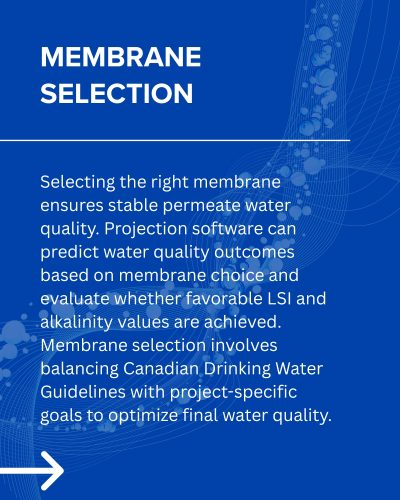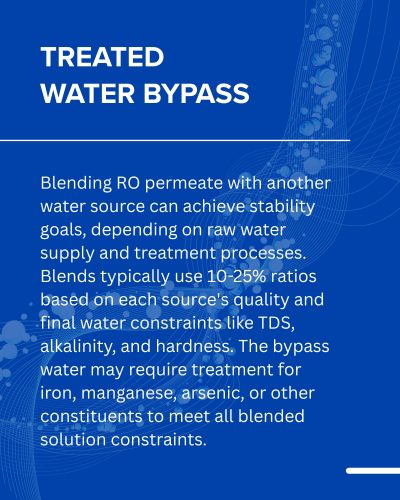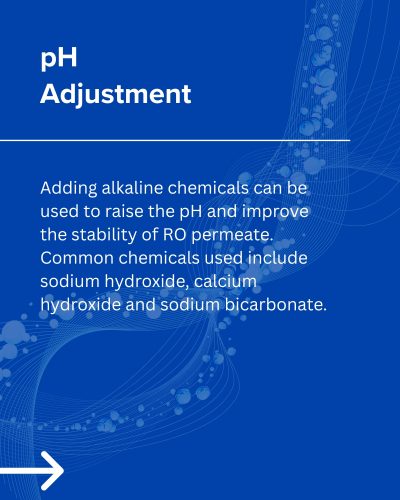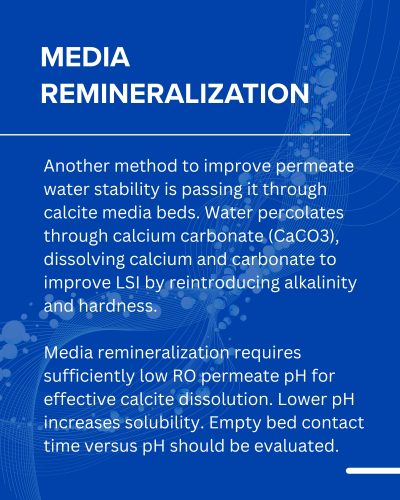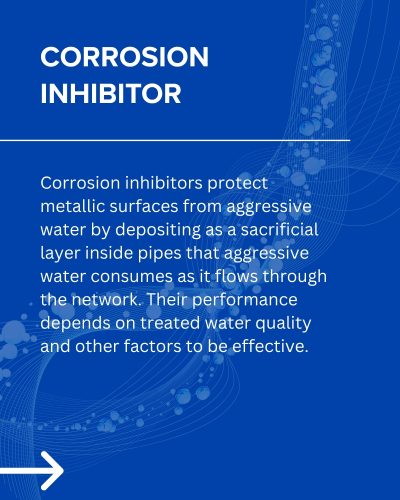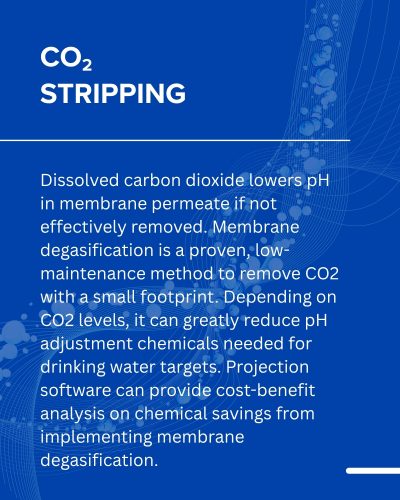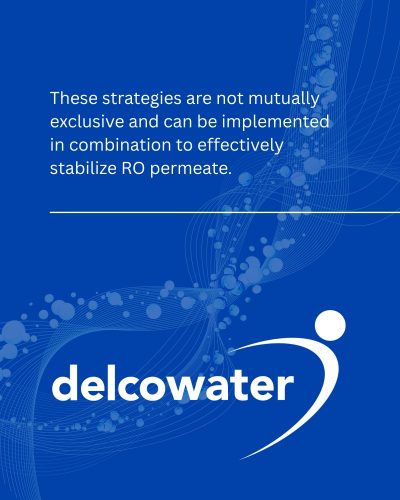Remineralization of Reverse Osmosis Permeate – Realizing Water Stability
Written by Kelsie Hubick
Reverse osmosis (RO) is one of the most effective water treatment technologies for removing contaminants such as total dissolved solids (TDS) and organic compounds, achieving removal rates commonly in the range of 95-99%. However, RO membranes are non-selective in what specific contaminants are being removed and strip water of beneficial minerals that assist in achieving water stabilization – like alkalinity. Water stability is a critical consideration in water treatment and distribution, as it impacts both water quality aesthetic characteristics and the integrity of infrastructure. To assess and manage corrosivity, a variety of indices have been developed to quantify water stability, with the Langelier Saturation Index (LSI) being the most widely used. RO permeate water can be termed corrosive, aggressive or unstable. Intervention strategies such as membrane selection, treated water bypass, pH adjustment, media remineralization and membrane degasification can stabilize RO permeate and protect distribution systems.
Water stability is defined as the tendency of water to either dissolve or deposit minerals depending on the properties of water, specifically pH, alkalinity, hardness and temperature. Water stability is a complex topic with many factors that are debated, but the one property that all parties agree on that effect water stability is pH. When pH is less than 7.0 water is considered acidic. Acidic water will have the highest tendency to lead to corrosion of any pipe material found in a distribution network (plastics having the most resistance). As a base course of action when considering strategies to combat aggressive RO permeate water, select strategies that will raise the pH of the permeate.
Finding a measurable result of the stability of water or a “corrosion index” that is solid, reproducible and consistent across multiple material types have been elusive. There are numerous methods of trying to predict the likelihood of corrosion. The first, and most common approach is to relate corrosion to the tendency for calcium carbonate to either scale or corrode. This approach has been how most existing indices have been generated. Common indices include Langelier Saturation Index (LSI), Ryznar Stability Index (RSI), Puckorius Scaling Index (PSI), Aggressiveness Index (AI) and Larson-Skold Index (LRI).
LSI, RSI and PSI are similar in that they all rely on the idea of a pH at which calcium carbonate (CaCO3) will be at saturation. The idea being, how close your actual pH is to the point of pH(s) (saturation limit for CaCO3) is at the limit. If you are higher than pH(s) you will deposit CaCO3 (scale). Less than the limit and you’ll begin to consume deposited CaCO3 (corrode). This is how a measurable result can be applied and determine if water will be scaling or corroding. The equations for these three indices are:
LSI = pH(measured) – pH(saturated – CaCO3)
pH(saturated – CaCO3) = (9.3+ A +B) – (C+D)
A = (Log10[TDS]-1)/10
B = -13.12xLog10(Temp(oC)+273)+34.55
C = Log10[Ca+2 (CaCO3)] -0.4
D = Log10[Alkalinity as CaCO3]
RSI = 2 x pH(saturated – CaCO3) – pH(measured)
PSI = 2 x pH(saturated – CaCO3) – pH(eq)
pH(eq) = 1.465 x Log10[Alkalinity] + 4.54
Aggressiveness Index (AI) and Larson-Skold Index (LRI) are less common but may be applicable in some applications. AI was developed for monitoring the effect of water on asbestos cement pipe.
AI = pHactual + log([Hardness] x [Alkalinity])
The most widely recognized index is Langelier Saturation Index (LSI). This is a well-known index that is frequently referenced when discussing water-based corrosion. LSI is interpreted as the pH change required to bring water to equilibrium – how much can a water hold before minerals deposit or “fall” out of solution. An ideal LSI is from a range of -1 to +1.
LSI <0: Undersaturated (aggressive/corrosive)
LSI = 0: Equilibrium (stable)
LSI>0: Oversaturated (scaling)
Although stability indices provide a level of predictability for corrosion, they do not account for all factors that may influence corrosion. For example, considerations that indices do not account for include dissolved oxygen, carbon dioxide, flowrates, pressure and pipe material, all of which can affect corrosion potential.
The following design strategies are discussed in preferential order when spiral wound membranes are included in the water treatment process. These strategies can be considered/evaluated to address the threat of corrosivity and achieve overall remineralization and permeate water stability.
- Membrane Selection
Making the effort in choosing the right membrane for the application will assist with permeate water stability. Projection software can offer predictions on permeate water quality based on what membrane is selected. Evaluations can be completed to see of a favorable LSI and alkalinity values are achieved. Limitations of membrane selection comes down to balancing constraints such as the Canadian Drinking Water Guidelines and project specific goals to strike a balance in final permeate water quality.
- Treated Water Bypass
Depending on the raw water supply and pre-treatment and parallel treatment processes, blending RO permeate with another source is another method to reach stability goals. Blends are typically implemented at 10-25% depending on the water quality of each source and final treated water constraints such as TDS, alkalinity and hardness. The bypass water may still need to be treated for items like iron, manganese, arsenic, or other constituents to keep the blended solution below all constraints.
- pH Adjustment
Adding alkaline chemicals can be used to raise the pH and improve the stability of RO permeate. Common chemicals used include sodium hydroxide, calcium hydroxide and sodium bicarbonate.
- Media Remineralization
Another means of improving water stability of permeate water, is to pass the treated water through a media bed such as calcite. In this example, a tank is filled with calcium carbonate (CaCO3) and water percolates through the media bed. The waters corrosive properties dissolve both calcium and carbonate which in turn improves LSI by reintroducing alkalinity and hardness back into the RO permeate.
It should be noted that media remineralization is dependent on the pH of the RO permeate, it must be sufficiently low to be effective on a reasonable time scale to dissolve the calcite. Lower pH means higher solubility. Empty bed contact time vs. pH should be evaluated.
- Corrosion Inhibitor
Corrosion inhibitors protect metallic surfaces from aggressive water in the system. The performance of these chemicals is dependent on several factors including the treated water quality to be effective. They are expected to deposit on the inside of the pipe network as a sacrificial layer that can be consumed by aggressive water as it flows through the pipe network.
- CO2 Stripping
Dissolved carbon dioxide can result in lower pH in membrane permeate water if it is not removed effectively. Membrane degasification is a proven, low-maintenance way to effectively remove carbon dioxide with a small plant footprint. Depending on levels of carbon dioxide, membrane degasification can greatly reduce the amount of pH adjustment chemicals that are required to reach appropriate targets for drinking water. A cost-benefit analysis can be completed from projection software on how much pH adjustment chemical can be saved by implementing membrane degasification.
These strategies are not mutually exclusive and can be implemented in combination to effectively stabilize RO permeate.
Water stabilization should be a consideration in spiral wound membrane treatment processes, such as RO. While stability indices such as LSI, RSI and PSI offer useful guidance and “rule of thumbs”, they don’t always capture all variables influencing corrosion. A comprehensive approach using the following design strategies of membrane selection, treated water bypass, chemical addition, calcite contactors and membrane degasification can be implemented to achieve an overall stable distribution water quality.
